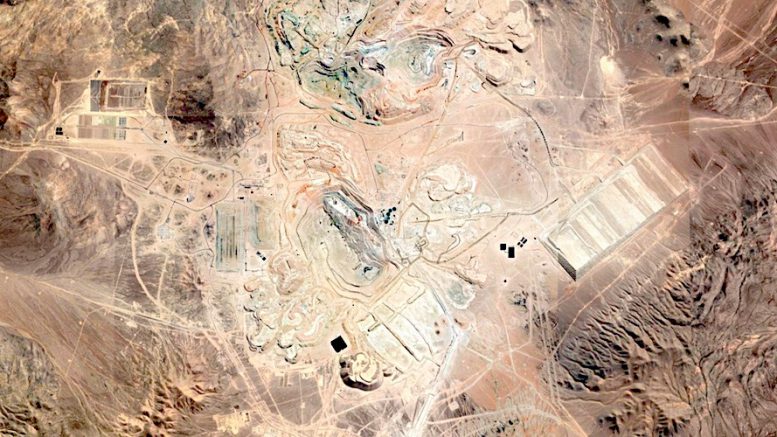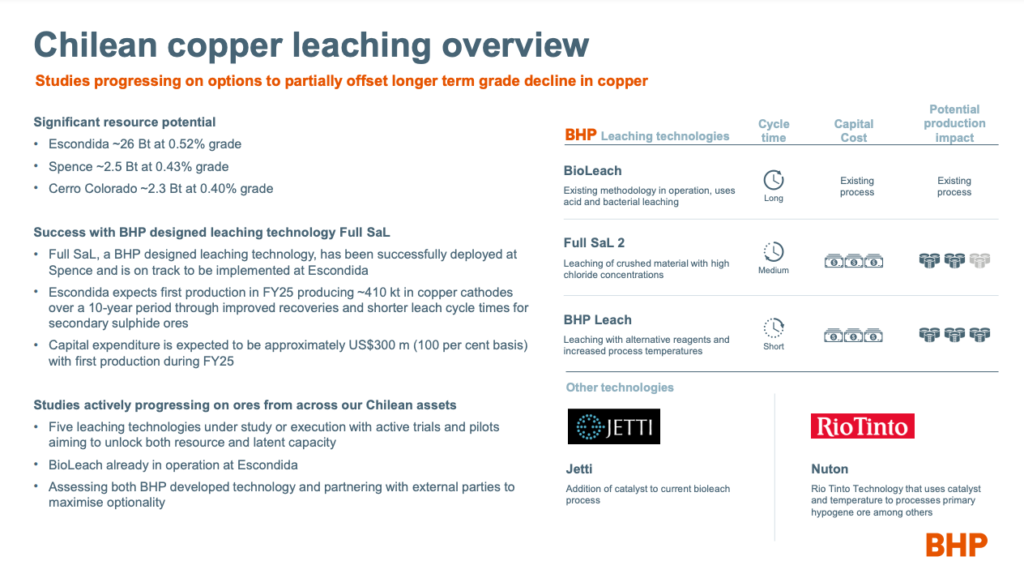BHP (ASX: BHP; LSE: BHP; NYSE: BHP) has kicked off a series of studies to carry out over the next 18 months at its operations in Chile, as the company seeks ways to offset the impact in the decline of concentrator feed grade expected from 2027.
The miner will begin with the implementation of its own leach technology, known as Full SaL (SaL standing for Simple Approach to Leaching), which is already paying off at the Spence operation in Chile.
Production of copper cathodes through Full SaL at Escondida is expected to reach about 410,000 tonnes over a 10-year period once implemented, thanks to improved recoveries and shorter leach cycle times.
BHP estimates the cost of implementing Full SaL will reach almost US$300 million ($405.9 million), and for first production to start during FY25, according to a presentation posted on its website.
The world’s largest miner is also evaluating a new concentrator for Escondida to replace the one at the Los Colorados plant.
BHP added it would explore alternatives for potentially extending the productive life of the Cerro Colorado mine, which is on track to cease operations this year upon expiration of its environmental licence.
The Australian mining giant expects costs associated with the studies announced as part of its operating costs, to increase to around US$140 million per year in both FY24 and FY25, from US$60 million in FY23.
Operating costs tied to Cerro Colorado’s closure are estimated to be around US$70 million and US$45 million for the December 2023 and June 2024 half years, respectively.
The mine could reopen as soon as 2030 thanks to the use of leaching technologies and desalinated water, subject to environmental approvals.
New solutions to old problems
Copper output in Chile, the world’s top producer, has been falling in recent years as miners face water restrictions due to a prolonged drought as well as a string of operational setbacks and project delays as they battle falling grades at the country’s aging mines.
The world’s biggest copper company, Chile’s Codelco, has not escaped the trend. Earlier this year, it said it expected production to fall as much as 7% in 2023 after already tumbling last year.
Cash costs at mines in Chile jumped 29% in the first three months of the year compared with the same period of 2022, according to a report released this week by government agency Cochilco.
BHP has five leaching technologies under study or execution, with trials aiming to unlock both resource and latent capacity. These include its own BioLeach technology that uses acid and bacterial leaching and which is already in use at Escondida, as well as Full SaL and BHP Leach. The other two are third party technologies: Jetti Resources’ catalytic leaching, in which BHP is an investor via BHP Ventures; and the Rio Tinto-owned (NYSE: RIO; LSE: RIO; ASX: RIO) Nuton venture, an elevated temperature bioleaching process.
BHP told local paper La Tercera it currently has more than 30 projects underway at Escondida, which include operational continuity and growth options.
Among them, the company is considering taking mining at Escondida underground, the replacement of diesel with solar energy and other decarbonization initiatives.
While majority-owned and operated by BHP, Rio Tinto and Japan-based JECO Corp also hold stakes in Escondida, the world’s largest copper mine.



Be the first to comment on "BHP mulls taking Escondida underground as it moves to unveil its own leach technology"